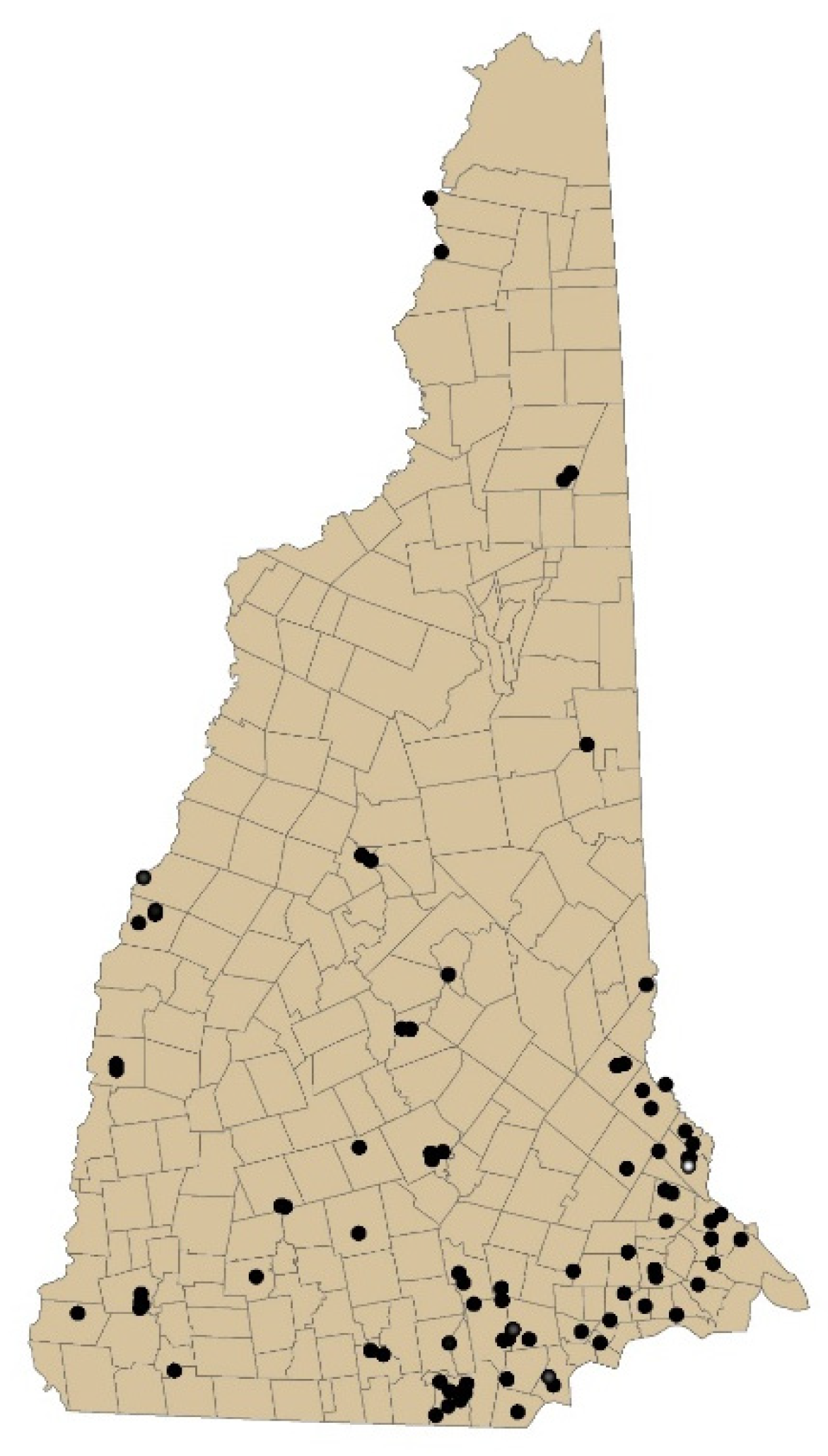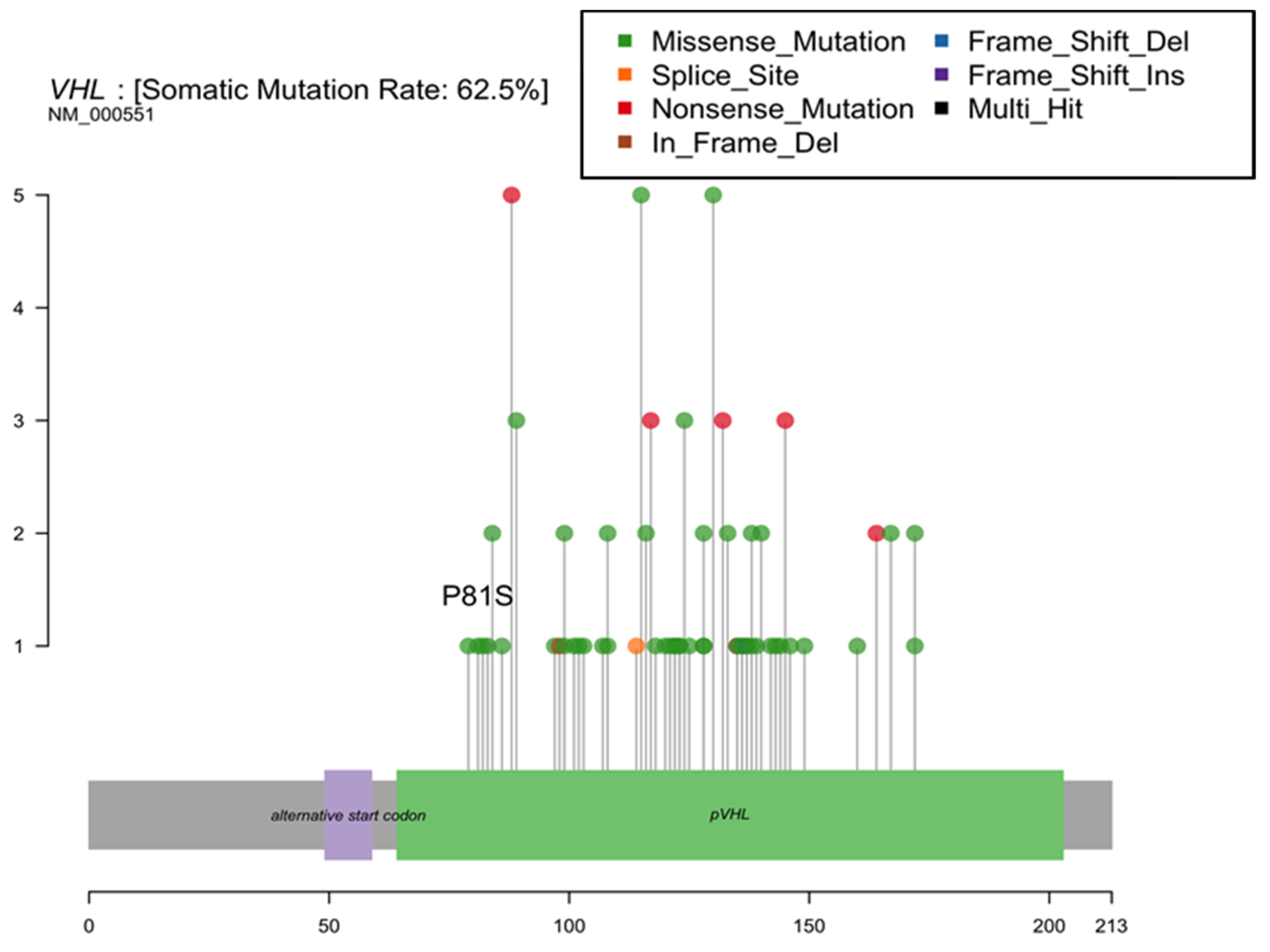Kidney Cancer Risk Associated with Historic Groundwater Trichloroethylene Contamination
Abstract
1. Introduction
2. Materials and Methods
3. Results
3.1. Population Characteristics
3.2. Kidney Cancer Risk Factors
3.3. Trichloroethylene in New Hampshire
3.4. Remediation of Contaminated Sites
3.5. Hotspot Mutation Assessment
4. Discussion
5. Conclusions
Author Contributions
Funding
Institutional Review Board Statement
Informed Consent Statement
Data Availability Statement
Acknowledgments
Conflicts of Interest
References
- Shingarev, R.; Jaimes, E.A. Renal cell carcinoma: New insights and challenges for a clinician scientist. Am. J. Physiol. Physiol. 2017, 313, F145–F154. [Google Scholar] [CrossRef]
- Cumberbatch, M.G.; Rota, M.; Catto, J.; La Vecchia, C. The Role of Tobacco Smoke in Bladder and Kidney Carcinogenesis: A Comparison of Exposures and Meta-analysis of Incidence and Mortality Risks. Eur. Urol. 2016, 70, 458–466. [Google Scholar] [CrossRef] [PubMed]
- Chow, W.-H.; Dong, L.M.; Devesa, S.S. Epidemiology and risk factors for kidney cancer. Nat. Rev. Urol. 2010, 7, 245–257. [Google Scholar] [CrossRef] [PubMed]
- National Toxicology Program Trichloroethylene; National Institute of Environmental Health Sciences: Durham, NC, USA, 2016.
- Guha, N.; Loomis, D.; Grosse, Y.; Lauby-Secretan, B.; El Ghissassi, F.; Bouvard, V.; Benbrahim-Tallaa, L.; Baan, R.; Mattock, H.; Straif, K. International Agency for Research on Cancer Monograph Working Group, Carcinogenicity of trichloroethylene, tetrachloroethylene, some other chlorinated solvents, and their metabolites. Lancet Oncol. 2012, 13, 1192–1193. [Google Scholar] [CrossRef]
- National Toxicology Program Monograph on Trichloroethylene; Division of the National Toxicology Program, National Institute of Environmental Health Sciences, U.S. Department of Health and Human Services: Durham, NC, USA, 2015.
- Agency for Toxic Substances and Disease Registry. Toxicological Profile for Trichloroethylene. In Division of Toxicology and Human Health Sciences; Agency for Toxic Substances and Disease Registry: Atlanta, GA, USA, 2019. [Google Scholar]
- Rusyn, I.; Chiu, W.A.; Lash, L.H.; Kromhout, H.; Hansen, J.; Guyton, K.Z. Trichloroethylene: Mechanistic, epidemiologic and other supporting evidence of carcinogenic hazard. Pharmacol. Ther. 2014, 141, 55–68. [Google Scholar] [CrossRef]
- Maltoni, C.; Lefemine, G.; Cotti, G. Experimental Research on Trichloroethylene Carcinogenesis; Princeton Scientific Publishing Co.: Princeton, NJ, USA, 1986; Volume V. [Google Scholar]
- Wilson, J.T.; Kampbell, D.H.; Weaver, J.W. In Environmental chemistry and the kinetics of biotransformation of chlorinated organic compounds in ground water. In Proceedings of the Symposium on Natural Attenuation of Chlorinated Organics in Ground Water, Dallas, TX, USA, 11–13 September 1996; pp. 124–127. [Google Scholar]
- Minnesota Pollution Control Agency. Site Remediaton Section Guidelines: Natural Attenuation of Chlorinated Solvents in Ground Water; Minnesota Pollution Control Agency: St. Paul, MN, USA, 2006.
- Illinois Department of Public Health Public Health Assessment: Lisle Residential Wells; Lisle: Clarinda, IL, USA, 2005.
- Shi, X.; Li, M.; Hunter, O.; Guetti, B.; Andrew, A.; Stommel, E.; Bradley, W.; Karagas, M. Estimation of environmental exposure: Interpolation, kernel density estimation or snapshotting. Ann. GIS 2019, 25, 1–8. [Google Scholar] [CrossRef]
- Greenland, S. Interpretation and Choice of Effect Measures in Epidemiologic Analyses. Am. J. Epidemiol. 1987, 125, 761–768. [Google Scholar] [CrossRef] [PubMed]
- Charbotel, B.; Fevotte, J.; Hours, M.; Martin, J.-L.; Bergeret, A. Case-control study on renal cell cancer and occupational exposure to trichloroethylene. Part II: Epidemiological aspects. Ann. Occup. Hyg. 2006, 50, 777–787. [Google Scholar] [CrossRef] [PubMed]
- Buhagen, M.; Grønskag, A.; Ragde, S.F.; Hilt, B. Association Between Kidney Cancer and Occupational Exposure to Trichloroethylene. J. Occup. Environ. Med. 2016, 58, 957–959. [Google Scholar] [CrossRef]
- Karami, S.; Lan, Q.; Rothman, N.; A Stewart, P.; Lee, K.-M.; Vermeulen, R.; Moore, L.E. Occupational trichloroethylene exposure and kidney cancer risk: A meta-analysis. Occup. Environ. Med. 2012, 69, 858–867. [Google Scholar] [CrossRef] [PubMed]
- Alanee, S.; Clemons, J.; Zahnd, W.; Sadowski, D.; Dynda, D. Trichloroethylene Is Associated with Kidney Cancer Mortality: A Population-based Analysis. Anticancer. Res. 2015, 35, 4009–4013. [Google Scholar]
- NH Department of Health and Human Services. Private Wells in New Hampshire. In Division of Public Health Services; NH Department of Health and Human Services: Concord, NH, USA, 2021. [Google Scholar]
- Interstate Technology & Regulatory Council (ITRC). Vapor Intrusion Pathway: A Practical Guideline; Technical and Regulatory Guidance, The Vapor Intrusion Team: Washington, DC, USA, 2007. [Google Scholar]
- U.S. Environmental Protection Agency. Background Indoor Air Concentrations of Volatile Organic Compounds in North American Residences (1990–2005): A Compilation of Statistics for Assessing Vapor Intrusion; EPA: Washington, DC, USA, 2011; Volume 530-R-10-001.
- Rust, S.; Drange, M. Google Employees Face Health Risks from Superfund Site’s Toxic Vapors; The Bay Citizen: San Francisco, CA, USA, 2013. [Google Scholar]
- Morrison, C. EPA to sample air for toxic chemicals near CTS site. Asheville Citizen-Times, 21 June 2014. [Google Scholar]
- Shen, R.; Suuberg, E.M. Impacts of changes of indoor air pressure and air exchange rate in vapor intrusion scenarios. Build. Environ. 2016, 96, 178–187. [Google Scholar] [CrossRef]
- Holton, C.; Luo, E.; Guo, Y.; Dahlen, P.; Johnson, P.C.; Gorder, K.; Dettenmaier, E. Multi-Year Monitoring of a House Over a Dilute CHC Plume: Implications for Pathway Assessment Using Indoor Air Sampling and Forced Under-Pressurization Tests; Fulton Schools of Engineering, Arizona State University: Tempe, AZ, USA, 2013. [Google Scholar]
- Press, D.J.; McKinley, M.; Deapen, D.; Clarke, C.A.; Gomez, S.L. Residential cancer cluster investigation nearby a Superfund Study Area with trichloroethylene contamination. Cancer Causes Control. 2016, 27, 607–613. [Google Scholar] [CrossRef]
- Jacquez, G.M.; Slotnick, M.J.; Meliker, J.R.; AvRuskin, G.; Copeland, G.; Nriagu, J. Accuracy of Commercially Available Residential Histories for Epidemiologic Studies. Am. J. Epidemiol. 2010, 173, 236–243. [Google Scholar] [CrossRef] [PubMed]
- Stinchcomb, D.G.; Roeser, A. NCI/SEER Residential History Project Technical Report; Westat, Inc.: Rockville, MD, USA, 2016. [Google Scholar]
- Mally, A.; Walker, C.L.; Everitt, J.I.; Dekant, W.; Vamvakas, S. Analysis of renal cell transformation following exposure to trichloroethene in vivo and its metabolite S-(dichlorovinyl)-l-cysteine in vitro. Toxicology 2006, 224, 108–118. [Google Scholar] [CrossRef]
- Lash, L.H.; Chiu, W.A.; Guyton, K.Z.; Rusyn, I. Trichloroethylene biotransformation and its role in mutagenicity, carcinogenicity and target organ toxicity. Mutat. Res. Mutat. Res. 2014, 762, 22–36. [Google Scholar] [CrossRef] [PubMed]
- Brauch, H.; Weirich, G.; Hornauer, M.A.; Storkel, S.; Wohl, T.; Bruning, T. Trichloroethylene exposure and specific somatic mutations in patients with renal cell carcinoma. J. Natl. Cancer Inst. 1999, 91, 854–868. [Google Scholar] [CrossRef][Green Version]
- DeSimone, M.C.; Rathmell, W.K.; Threadgill, D.W. Pleiotropic Effects of the Trichloroethylene-Associated P81S VHL Mutation on Metabolism, Apoptosis, and ATM-Mediated DNA Damage Response. J. Natl. Cancer Inst. 2013, 105, 1355–1364. [Google Scholar] [CrossRef] [PubMed]
- Wells, G.; Schroth, W.; Brauch, H.; Ross, E. Bilateral renal-cell carcinoma associated with an acquired VHL mutation and long-term trichloroethylene exposure. Clin. Nephrol. 2009, 71, 708–713. [Google Scholar] [CrossRef]
- Charbotel, B.; Gad, S.; Caïola, D.; Béroud, C.; Fevotte, J.; Bergeret, A.; Ferlicot, S.; Richard, S. Trichloroethylene exposure and somatic mutations of the VHL gene in patients with Renal Cell Carcinoma. J. Occup. Med. Toxicol. 2007, 2, 13. [Google Scholar] [CrossRef] [PubMed]
- Bren, U.; Zupan, M.; Guengerich, F.P.; Mavri, J. Chemical Reactivity as a Tool to Study Carcinogenicity: Reaction between Chloroethylene Oxide and Guanine. J. Org. Chem. 2006, 71, 4078–4084. [Google Scholar] [CrossRef] [PubMed]
- Hu, J.; Mao, Y.; White, K. The Canadian Cancer Registries Epidemiology Research Group Renal cell carcinoma and occupational exposure to chemicals in Canada. Occup. Med. 2002, 52, 157–164. [Google Scholar] [CrossRef] [PubMed]



| Controls | Cases | p-Value | ||
|---|---|---|---|---|
| Characteristic | N = 448 (%) | N = 292 (%) | ||
| Age | 1–55 | 100 (22.3) | 62 (21.2) | 0.92 |
| >55–65 | 118 (26.3) | 79 (27.1) | ||
| >65–75 | 144 (32.1) | 99 (33.9) | ||
| >75 | 86 (19.2) | 52 (17.8) | ||
| Sex | Female | 169 (37.7) | 98 (33.6) | 0.28 |
| Male | 279 (62.3) | 194 (66.4) | ||
| Ethnicity | Hispanic or Latino/Unknown | 9 (2.0) | 7 (2.4) | 0.63 |
| Not Hispanic nor Latino | 439 (98.0) | 283 (97.6) | ||
| Race | Other/Unknown | 8 (1.8) | 6 (2.1) | 0.20 |
| White | 440 (98.2) | 284 (97.9) |
| Control | Controls | Cases | |||||
|---|---|---|---|---|---|---|---|
| Decayed TCE Exposure | Percentile | TCE (ug/L) | N = 448 (%) | N = 292 (%) | p-Value | OR * (95%CI) | |
| 5-year median | <50th | 0 | 290 (65.8) | 189 (66.1) | 0.14 | 1.0 (ref) | |
| 50th–75th | >0–25.3 | 41 (9.3) | 38 (13.3) | 1.47 | (0.89–2.42) | ||
| ≥75th | ≥25.3 | 110 (24.9) | 59 (20.6) | 0.85 | (0.58–1.24) | ||
| 10-year median | <50th | 0 | 294 (66.7) | 190 (66.4) | 0.169 | 1.0 (ref) | |
| 50th–75th | >0–27.3 | 37 (8.4) | 35 (12.2) | 1.51 | (0.90–2.54) | ||
| ≥75th | ≥27.3 | 110 (24.9) | 61 (21.3) | 0.89 | (0.61–1.30) | ||
| 15-year median | <50th | 0 | 298 (67.6) | 189 (66.1) | 0.081 | 1.0 (ref) | |
| 50th–75th | >0–27.6 | 33 (7.5) | 35 (12.2) | 1.78 | (1.05–3.03) | ||
| ≥75th | ≥27.6 | 110 (24.9) | 62 (21.7) | 0.92 | (0.63–1.34) | ||
Publisher’s Note: MDPI stays neutral with regard to jurisdictional claims in published maps and institutional affiliations. |
© 2022 by the authors. Licensee MDPI, Basel, Switzerland. This article is an open access article distributed under the terms and conditions of the Creative Commons Attribution (CC BY) license (https://creativecommons.org/licenses/by/4.0/).
Share and Cite
Andrew, A.S.; Li, M.; Shi, X.; Rees, J.R.; Craver, K.M.; Petali, J.M. Kidney Cancer Risk Associated with Historic Groundwater Trichloroethylene Contamination. Int. J. Environ. Res. Public Health 2022, 19, 618. https://doi.org/10.3390/ijerph19020618
Andrew AS, Li M, Shi X, Rees JR, Craver KM, Petali JM. Kidney Cancer Risk Associated with Historic Groundwater Trichloroethylene Contamination. International Journal of Environmental Research and Public Health. 2022; 19(2):618. https://doi.org/10.3390/ijerph19020618
Chicago/Turabian StyleAndrew, Angeline S., Meifang Li, Xun Shi, Judy R. Rees, Karen M. Craver, and Jonathan M. Petali. 2022. "Kidney Cancer Risk Associated with Historic Groundwater Trichloroethylene Contamination" International Journal of Environmental Research and Public Health 19, no. 2: 618. https://doi.org/10.3390/ijerph19020618
APA StyleAndrew, A. S., Li, M., Shi, X., Rees, J. R., Craver, K. M., & Petali, J. M. (2022). Kidney Cancer Risk Associated with Historic Groundwater Trichloroethylene Contamination. International Journal of Environmental Research and Public Health, 19(2), 618. https://doi.org/10.3390/ijerph19020618






